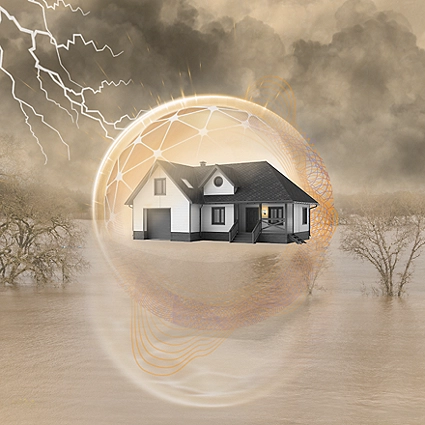🔍 What Is Business Interruption Insurance.
Business Interruption Insurance (BII) is a type of coverage that compensates a business for income loss resulting from a disruption to normal operations due to a covered event like fire, natural disaster, or equipment breakdown.
It is not a standalone policy but is usually bundled with:
- Commercial Property Insurance
- Business Owner’s Policy (BOP)
Key Purpose: To help businesses survive financially during periods when they cannot operate and generate income.
✅ What Does Business Interruption Insurance Cover.
| Coverage Area | Explanation |
|---|---|
| 💰 Lost Revenue | Replaces income you would have earned if the business had stayed open |
| 🧾 Fixed Costs | Covers rent, salaries, loan repayments, utilities, taxes |
| 🔁 Temporary Relocation | Cost of moving to and operating from a temporary location |
| ⚙️ Training Costs | Retraining employees to use replacement equipment or new systems |
| 💻 Extra Expenses | Additional costs to avoid total shutdown (e.g., renting equipment) |
| ⏳ Extended Recovery Time | Covers lost income even after reopening while customer traffic rebuilds |
🏢 Who Needs Business Interruption Insurance.
Essential for any business that relies on:
- A physical location to operate
- A supply chain or key vendors
- Regular customer foot traffic
- In-person equipment or machinery use
Common Sectors:
- Restaurants & Cafes
- Retail Stores
- Manufacturers & Warehouses
- Medical Clinics
- Hotels & Hospitality
- Law & Accounting Firms
🛑 Without BII, these businesses risk permanent closure after just weeks of downtime.
🧯 Covered Events
| Covered Events | Examples |
|---|---|
| 🔥 Fire or Explosion | Fire damages building, equipment, or inventory |
| 💧 Water Damage | Burst pipe floods store or office |
| ❄️ Storm Damage | Roof collapses due to snow or high winds |
| 🛠️ Equipment Failure | Breakdown of essential machinery |
| 🚫 Civil Authority Shutdown | Road closures or curfews due to nearby fire or crime scene (with rider) |
| 👨💻 Cyberattacks | Ransomware or DDoS attacks causing business shutdown (with add-on) |
❌ What’s Not Covered
| Not Covered | Explanation |
|---|---|
| Physical property damage | Handled by property insurance, not BII |
| Utilities Outages | Unless caused by covered peril on-site |
| Pandemic/virus closures | Typically excluded unless added (e.g., COVID-19) |
| Undocumented income | If not reported in tax filings, it’s not reimbursed |
| War, nuclear events, terrorism | Usually excluded unless specifically included |
| Voluntary closure | Losses from choosing to close aren’t covered |
🧾 Example Scenario
Business: A bakery
Event: Electrical fire damages the kitchen; business closes for 2 months.
| Expense | Outcome |
|---|---|
| Equipment repair | Covered by property insurance |
| Lost income during closure | Covered by Business Interruption Insurance |
| Rent, payroll, and utilities | Covered by BII |
| Temporary rental of kitchen | Covered under “extra expense” in BII |
| Marketing to announce reopening | Not typically covered |
💵 How Premiums Are Calculated
Factors That Affect Cost:
- Industry and business type
- Revenue and profit margin
- Location (disaster risk level)
- Building age and fire protection
- Coverage limit and indemnity period
Average Cost (US & UK Estimate, Annually):
| Business Size | Estimated Cost |
|---|---|
| Small business (retail/office) | $500 – $1,200/year |
| Medium-sized restaurant or clinic | $1,000 – $3,000/year |
| Large warehouse or manufacturer | $3,000 – $10,000/year |
⏱️ Coverage Duration (Indemnity Period)
- Standard coverage lasts 12 months
- Can be extended to 24 or 36 months depending on policy
- Begins on the date of the event and ends when the business is restored to pre-loss condition
⏳ Be realistic: Some businesses need months to fully recover, even after reopening.
➕ Optional Add-Ons and Riders
| Add-On | Description |
|---|---|
| 🔄 Extended Indemnity | Covers recovery period after reopening |
| 🏗️ Contingent Business Interruption | Covers losses due to supplier/vendor issues |
| 👩⚖️ Civil Authority Coverage | When a government closure prevents business access |
| 🧠 Cyber BII | Covers revenue loss due to system hacks or outages |
| 🌊 Flood/Earthquake | Must be added in high-risk areas (not usually standard) |
🧠 How to Calculate Required Coverage
You need to determine:
- Monthly gross profits
- Fixed monthly operating costs
- Expected downtime duration
Example Calculation:
| Expense | Monthly Cost |
|---|---|
| Gross Profit | $15,000 |
| Rent | $2,000 |
| Staff Salaries | $6,000 |
| Utilities & Taxes | $1,000 |
| Loan Repayments | $2,000 |
If downtime = 3 months, you may need at least $75,000 in BII coverage.
📋 How to File a Business Interruption Claim
- Notify your insurer as soon as disruption occurs
- Gather proof of loss (tax returns, revenue reports, expense logs)
- Work with a loss adjuster for evaluation
- Keep records of all expenses during downtime
- Cooperate with inspections and documentation requirements
✅ Summary Table
| Feature | Details |
|---|---|
| Covers | Lost income, fixed costs, extra expenses |
| Triggered by | Fire, flood, disaster, cyberattack (if added) |
| Doesn’t cover | Physical damage, pandemics, utility outage |
| Who needs it | Any business that can’t afford long downtime |
| Cost | $500–$10,000/year depending on size and sector |
| Policy type | Part of BOP or Commercial Property Policy |


